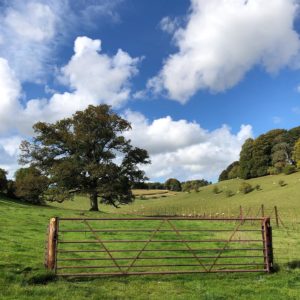Farming in Cranborne Chase National Landscape

Agriculture is a major influence on the landscape character and quality of Cranborne Chase, with 89% of the National Landscape being farmland. This is compared to the South West farmland percentage of 74%, showing how significant and impactful agricultural land use and employment is in this landscape.
Managed in typically large land holdings, there are 528 holdings covering 87,247 hectares, 7,588 hectares of which is woodland. Cranborne Chase has one of the lowest population densities in the South West with 33,000 residents and around 20% of those are employed in agriculture.
Over half of the farmland in Cranborne Chase National Landscape is used for cropping, with cereals being the major type of crop. Whereas nearly a third is pasture or rough grazing land, mostly permanent grassland. Sheep are the most common livestock that you will see grazing on the landscape, followed by a high proportion of dairy livestock and a small number of beef cows and pigs.
Additional rural land management in the National Landscape includes game shooting, which supports the local economy by attracting a large number of day and weekend visitors. The diversification of farms across the National Landscapes has also brought the emergence of an array of non-agricultural enterprises. See our Explore section to view some of these businesses in the landscape.
Find out how farming is changing in National Landscapes.

On 1st January 2021, the Agricultural Transition Period started, a Government plan which is put into place by the Department for Environment, Food, and Rural Affairs (DEFRA).
As part of this period (2021 – 2027), DEFRA will gradually be reducing, and then finally cease, all untargeted Direct Payments.
What Does this Mean?
Direct Payments are paid to farm businesses based on the amount of agricultural land they maintain, and has been in place since 1957. However, evidence suggests that Direct Payments offer poor value for money, and introduce distortionary incentives. There is evidence that they inflate farm rents, and hinder productivity and growth.
For more information, please see the following links:
What will happen next?
The money that would have been spent on the Direct Payments is being planned to be used to support agriculture in a number of ways.
Farmers will be paid to improve the environment, improve animal health and welfare, and to reduce carbon emissions.
The funding will be aimed at three levels of support. These will be:
- Investing in sustainable farming practices
- Creating habitats for nature recovery
- Making landscape-scale change for ecosystems

Some options will be universally open to all farmers and land managers, while others will be more targeted at a smaller number of large projects.
There will also be significant grants made available to support farmers to reduce their costs and improve their profitability, to help those who want to retire or leave the industry, and to create new opportunities and support for new entrants coming into the industry.
DEFRA Tests and Trials – The ‘Farming for the Nation’ Project

Cranborne Chase National Landscape is one of 12 designated Area’s of Outstanding Natural Beauty that took part in a DEFRA Tests and Trials project called ‘Farming for the Nation’.
The final report of the Environmental Land Management Scheme Test can be found here:
The results of a ‘Virtual Workshop’ held with land managers in 2020 with follow up questionnaires can be read here:
The National Landscapes that took part were testing new ways for DEFRA to incentivise environmentally friendly approaches to farming.
While it might seem straightforward on paper, in practice it’s not that easy to measure how ‘good’ or valuable a piece of grassland is other than its capacity for feeding livestock.
What wildlife does it support? How much carbon is it storing? How much rainwater does it absorb compared to concrete or bare cultivated ground, that otherwise might flow into a river or onto a road taking large quantities of soil with it and possible agrochemicals? How do you measure a hedge for its potential as nesting habitat for birds?
These questions are complicated and far reaching, and so require many tests and consultations and discussions.
Farmer Groups
Farmers and land managers working together can deliver greater benefits, especially at a landscape scale.
Cranborne Chase National Landscape has a large number of farmer groups, who are helped by advisors or ‘facilitators’. We work with these groups and work is funded by existing agri-environment schemes or through additional funding.

We recently received funding from Natural England’s Facilitation Fund to fund the facilitation of our Nadder Valley Farmer Group.
- Allenford
- Chalke Valley Farmer Cluster which is part of the Martin Down Farmer Supercluster which has its own Twitter page with more information
- Nadder Valley
- Tarrant Valley
- Wylye Valley Farmers
For more information about these groups, please contact info@cranbornechase.org.uk.
Woodlands
The National Landscape has been identified as an Ancient Woodland Priority Area by the Forestry Commission (from 2009 onwards).
Ancient woodlands and trees represent a living cultural heritage, a natural equivalent to our great churches and castles. They are also our richest wildlife habitat and are highly valued by people as places of tranquility and inspiration.
The Forestry Commission are seeking to protect and enhance the ancient and native woodlands of the South West and increase the area of native woodland. This is achieved by offering grants under the English Woodland Grant Scheme and by working in partnership with organisation such as this National Landscape.
For more details see the Forestry Commission Website.
